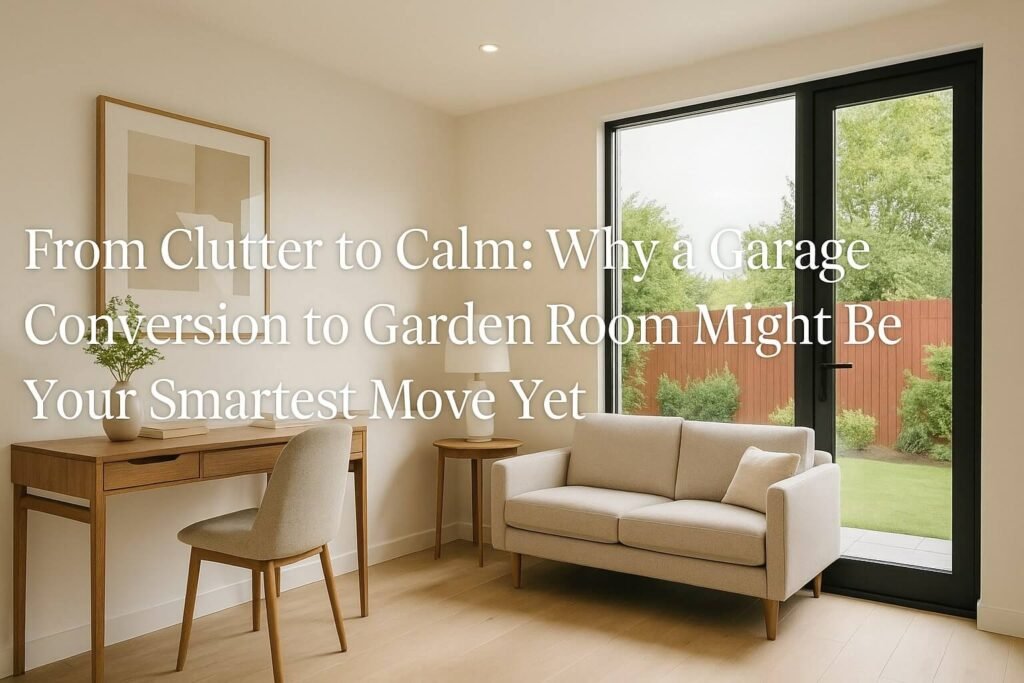Once a cold, concrete box used for little more than storing forgotten gym equipment and old tins of paint, your garage could be hiding the potential for something far more valuable. A garage conversion to garden room is quickly becoming one of the most cost-effective and rewarding ways to expand your living space without laying new foundations or carving up your outdoor area. If you’ve ever daydreamed of a quiet office nook, a sunny studio, or just a space to think clearly and breathe, this might be the home upgrade you didn’t know you were ready for.
What Makes Garage Conversion to Garden Room So Popular Right Now?
It starts with the maths. Converting an existing garage into a garden room can often cost less than half of what you’d pay for a traditional extension or even a standalone garden pod. Because you’re building from an existing structure, you skip the expense of foundations and most structural walls. With prices starting around £800–£1,150 per square metre, it sits comfortably under the £1,500 per square metre benchmark for purpose-built outbuildings.
Beyond the savings, it’s about location and light. A garage that backs onto your garden already has one foot in the outdoors, making it a natural candidate for big windows or French doors that draw in light and let you spill out into the greenery. That’s why many homeowners opt to turn their old garages into creative studios, hybrid office-guest spaces, or even yoga sanctuaries. You’re not just adding a room. You’re adding a room that feels like it’s floating between house and garden, indoors and out.
There’s also the planning advantage. Most garage conversions, especially when kept single-storey and within the footprint of the original build, fall under permitted development in the UK. That means no full planning application is needed unless you live in a conservation area or a listed property. You’ll still need to follow Building Regulations, especially for insulation, ventilation, and fire safety, but you can often move from first idea to finished space in under two months if your build team knows what they’re doing.
Practical Considerations Before You Start
Even with the structure already standing, it pays to plan carefully. Most garages weren’t built with comfort in mind, so the first upgrade is insulation. Floors can be cold and prone to damp, so a typical retrofit includes a damp-proof membrane, 75–100 mm of PIR insulation, and chipboard flooring before any surface finishes. Walls might need insulated plasterboard or internal studwork with mineral wool or PIR foam to meet modern thermal standards.
Windows are more than just an aesthetic touch. Natural light makes a modest garden room feel expansive. Whether you go for a rooflight, side window or wide rear patio doors, make sure they’re double glazed and thermally efficient. Consider wiring early too – at least two double sockets per wall, ethernet for a strong internet connection, and maybe even a small panel heater controlled by a smart thermostat.
And don’t forget the unexpected. Drainage surveys, hidden asbestos in ceilings, or outdated electrics can all add a twist to your timeline or budget. Build in a 10% contingency from the start so surprises don’t derail the momentum.
Life After the Conversion: What Changes Most
There’s something about walking into a space you created from what was once dead square footage. Clients who’ve done a garage conversion to garden room talk about the change in energy more than anything. Suddenly there’s a place to work without interruption, to paint while the sun tracks across the sky, or to finally start that indoor garden. The space becomes whatever your life needs next. And if one day you decide to sell, estate agents are likely to highlight it as a unique, multi-purpose room that adds year-round function and style to your home.
It’s not just about adding value to your house – though that certainly helps. It’s about transforming how you live inside it. One quiet step outside the chaos of the kitchen or living room, and suddenly you’ve found a whole new rhythm. Not bad for a space you barely noticed a year ago.


